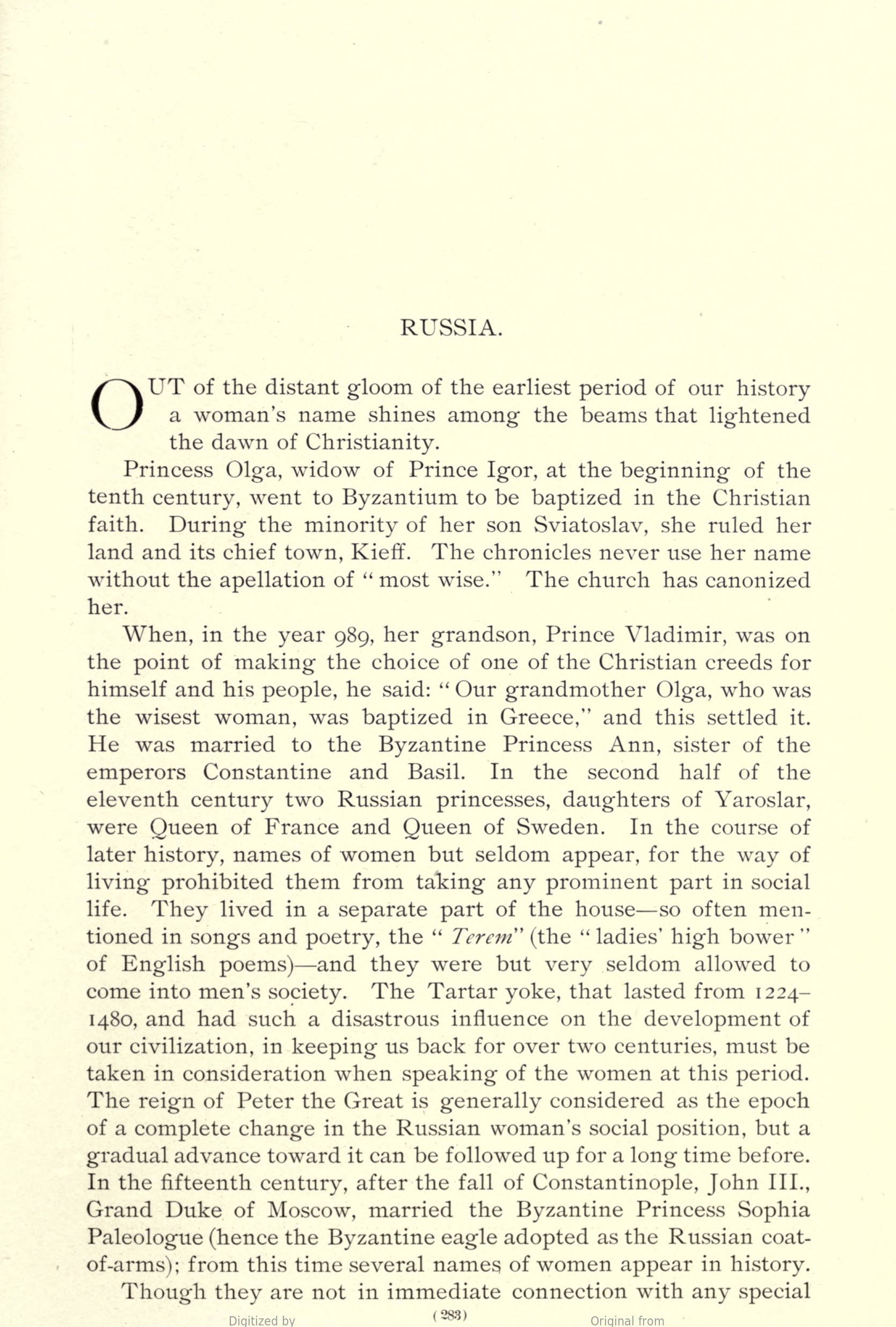
RUSSIA.
OUT of the distant gloom of the earliest period of our history a woman's name shines among the beams that lightened the dawn of Christianity.
Princess Olga, widow of Prince Igor, at the beginning of the tenth century, went to Byzantium to be baptized in the Christian faith. During the minority of her son Sviatoslav, she ruled her land and its chief town, Kieff. The chronicles never use her name without the apellation of "most wise." The church has canonized her.
When, in the year 989, her grandson, Prince Vladimir, was on the point of making the choice of one of the Christian creeds for himself and his people, he said: "Our grandmother Olga, who was the wisest woman, was baptized in Greece," and this settled it. He was married to the Byzantine Princess Ann, sister of the emperors Constantine and Basil. In the second half of the eleventh century two Russian princesses, daughters of Yaroslar, were Queen of France and Queen of Sweden. In the course of later history, names of women but seldom appear, for the way of living prohibited them from taking any prominent part in social life. They lived in a separate part of the house—so often mentioned in songs and poetry, the "Terem" (the "ladies' high bower" of English poems)—and they were but very seldom allowed to come into men's society. The Tartar yoke, that lasted from 1224-1480, and had such a disastrous influence on the development of our civilization, in keeping us back for over two centuries, must be taken in consideration when speaking of the women at this period. The reign of Peter the Great is generally considered as the epoch of a complete change in the Russian woman's social position, but a gradual advance toward it can be followed up for a long time before. In the fifteenth century, after the fall of Constantinople, John III., Grand Duke of Moscow, married the Byzantine Princess Sophia Paleologue (hence the Byzantine eagle adopted as the Russian coat-of-arms); from this time several names of women appear in history.
Though they are not in immediate connection with any special
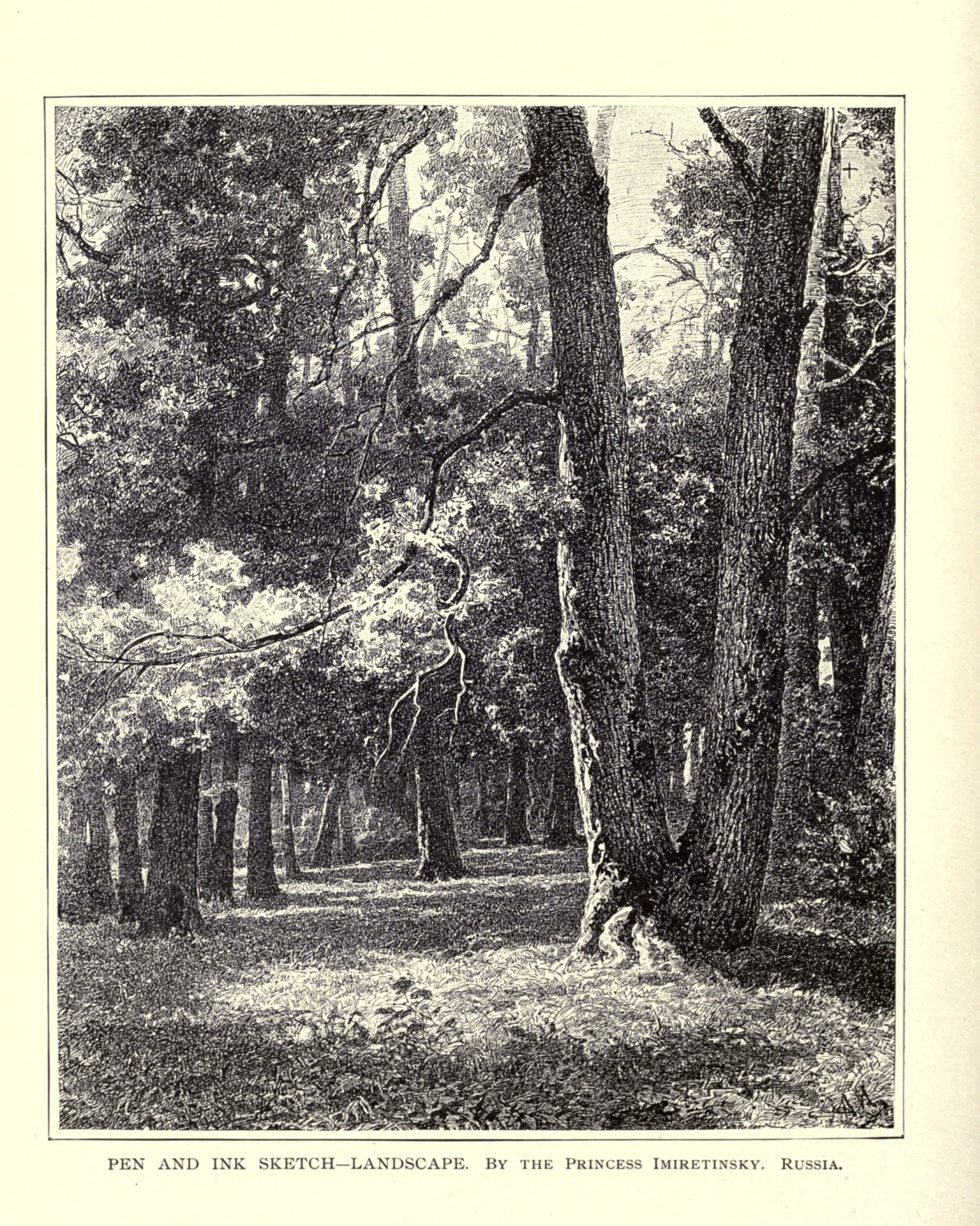
PEN AND INK SKETCH—
LANDSCAPE.
BY THE PRINCESS IMIRETINSKI.
RUSSIA.

event, they must be mentioned on account of the influence they had on their surroundings. In the beginning of the sixteenth century the handsome and intelligent Helen Glinsky was known for the power she had over her husband, Grand Duke Vassili, father of John IV. A happy period in the reign of this cruel monarch, surnamed "The Terrible," is due to the influence of Anastasia Romanovna, one of his seven wives. His son Theodor's wife, Jrina Godounova, was extolled by all foreign travelers and ambassadors who came to Moscow, for her charms and beauty and her wise and loving dealings with her husband, who lacked strength both in mind and body.
In the second half of the seventeenth century, the family of the boyar Artamon Matveieff was one of the most cultivated in Moscow. In this house Tsar Alexis (the second of the present reigning family of Romanoffs), who was a widower at this time, met the young Nathalie Kirilovna Narishkine, his host's ward. The handsome girl captivated the sovereign's heart, became his wife, and mother of Peter the Great.
By his first wife Alexis had a daughter who was certainly one of the most remarkable figures of her time. She was intelligent and devoted to literature, encouraged dramatic art, and composed some tragedies, which unfortunately are lost. During the minority of her brothers, John and Peter, the Princess Sophia ruled the kingdom in their name. Foreign ambassadors who were received in state at the Muscovite court were strongly impressed by the sight of two royal boys sitting on a double-seated throne, and obeying the whisper of a female voice coming from behind a curtain. Her political wisdom and popularity among the people and the army were such that Peter, at a later period, considered her of such dangerous importance that she was captured, relegated to a monastery, and forced to take the veil.
The first years of the last century mark the turning-point in our women's social life. Among the innovations that Peter the Great imposed on the society of the newly rising St. Petersburg were the so-called "assemblies," or evening parties, held at court, where ladies were obliged to be present, much to the annoyance of the grumbling partisans of "olden times." After Peter the Great's death, in 1725, his widow, Catharine I., was the first of a series of women who sat on the imperial throne, interrupted only by the short reigns of Peter II. and Peter III. These empresses were Ann, Duchess of Courland, Peter the Great's niece; Elizabeth, his daughter; and lastly, Catharine II. the Great.
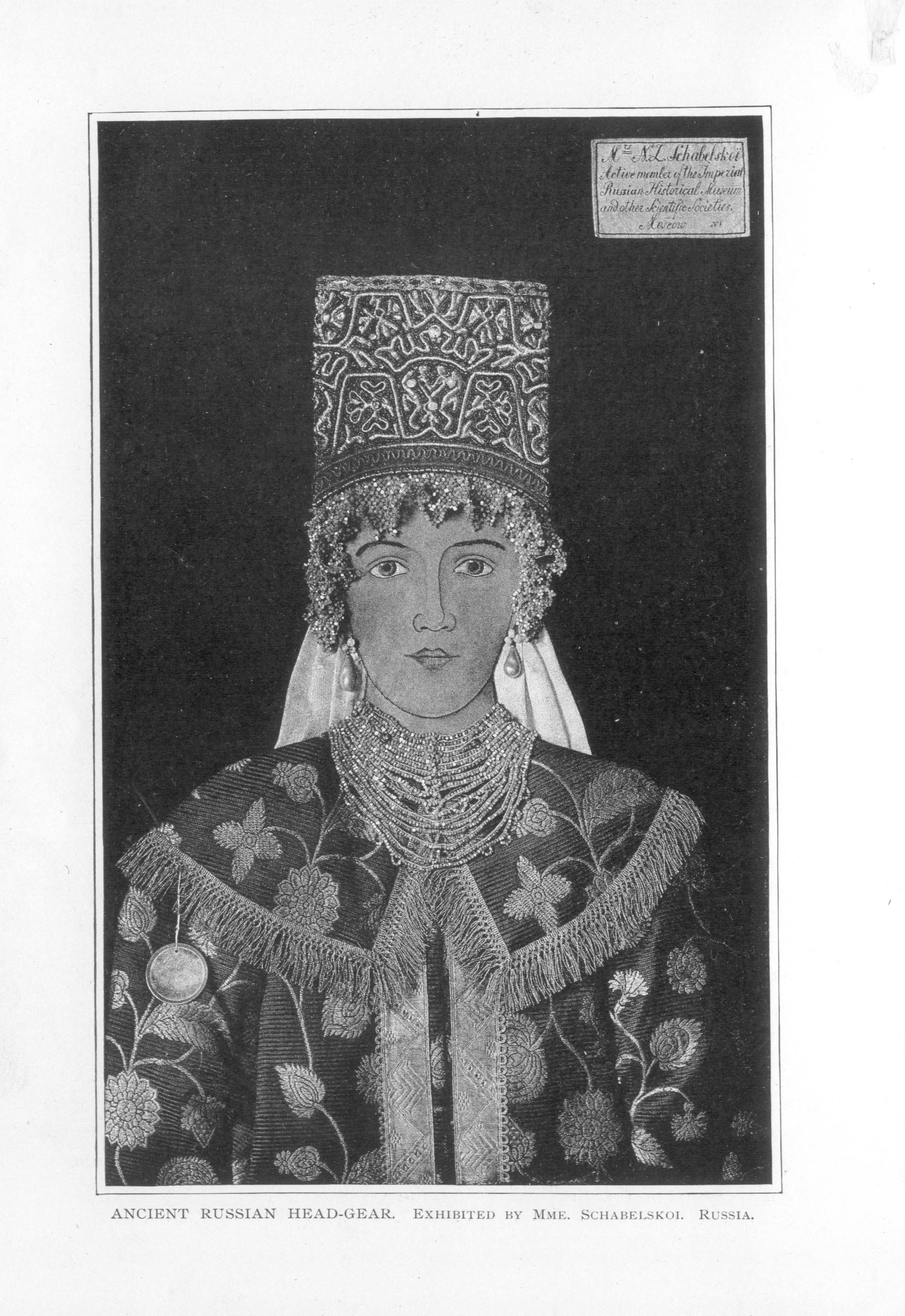
ANCIENT RUSSIAN HEAD-GEAR.
EXHIBITED BY MME. SCHABELSKOI.
RUSSIA.

A mention is due of the name of the famous friend of the latter, the Princess Dashkoff, president of the Academy of Science in St. Petersburg. Of great culture and learning, she was known as well abroad as in Russia. She had traveled much, and carried on a large correspondence with scientific men. Her interesting memoirs, written in French, form a volume of the "Prince Worontzoff's archives."
The first female educational institutions date from the reign of Catharine the Great. Seminaries for girls of noble families were founded, the education given being somewhat like the French convent education.
Empress Maria Theodorovna, wife of Paul I., continued the same work. With untiring and never-failing love she encouraged all private and official activity in the field of education and charity. The number of seminaries, schools, hospitals, homes, etc., opened under her high patronage grew to such an extent that after her death it was considered necessary to found a special ministry for their management; they formed the "Institutions of Empress Maria," and have been ever since the object of special care to all our empresses.
In the middle of this century rises a brilliant name indissolubly connected with all the great events of her time. The Grand Duchess Helene Pavlovna, sister-in-law of Nicholas I., was remarkable, not only for her talents, but also for the fascinating power she had of attracting around her all who were prominent in literature, art, science, and politics. The musical and literary gatherings in the "Palais Michel" were famous. She founded and was the first president of the St. Petersburg Musical Conservatory. Emperor Alexander II. highly appreciated her intelligence, and she was one of his nearest counselors in the great act of the emancipation of serfs. In her charity and educational activity, which was great, she was efficiently assisted by Baroness Edith Rahden. The work is continued by her daughter, the Grand Duchess Catherine, who is at the head of the institutions and schools of the Patriotic Society.
This brings us to our own times, in which the great increase of feminine activity strikes us so much that I feel the insufficiency of my pen to do justice to this vast theme. So many namse shine in so many different branches that it is impossible to give here any just account of this activity. A great impulse to education has been given by the foundation of establishments of different types, especially gymnasiums and progymnasiums, not only in the

LANDSCAPE.
PRINCESS IMRETINSKI.
RUSSIA.

REPRODUCTION OF CURTAIN OF THE THRONE OF THE CZARS
JEAN AND PETER, 1681.
LENT BY MME. SCHABELSKOI, MEMBER OF THE IMPERIAL RUSSIAN HISTORICAL MUSEUM.
chief towns, but even in the small provincial places. Finally the higher university education was opened to women in 1872, in Petersburg, Moscow, Kieff, and Kharkoff. Private initiative and means have greatly contributed to the development of the intermediate and higher education, such as the gymnasiums of Mme. Taganzeff Soiounine, Princess Obolensky in Petersburg, Mme.
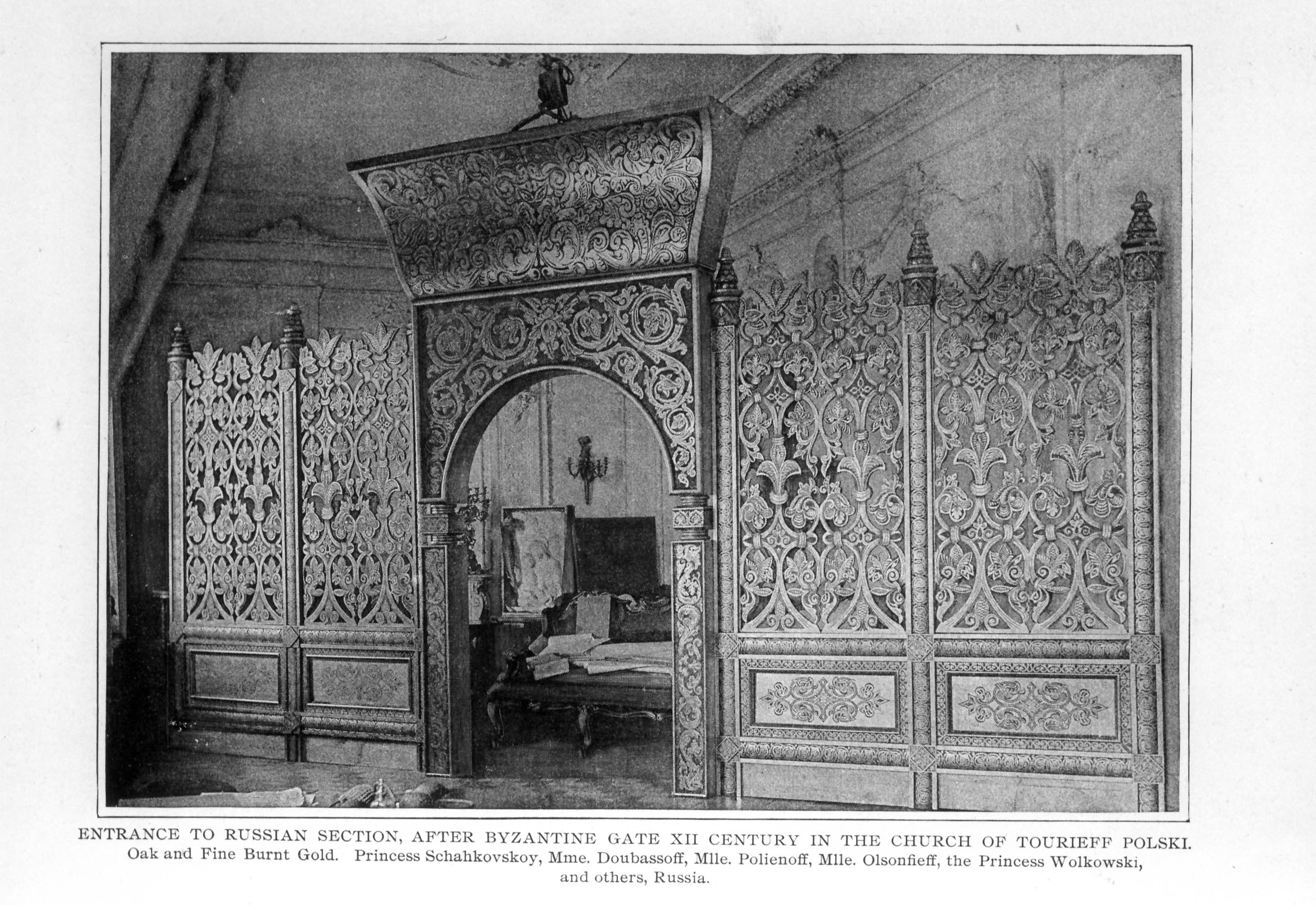
ENTRANCE TO RUSSIAN SECTION, AFTER BYZANTINE GATE XII CENTURY IN THE CHURCH OF TOURIEFF POLSKI.
Oak and Fine Burnt Gold.
Princess Schahkovskoy, Mme. Doubassoff, Mlle. Polienoff, Mlle. Olsonfieff, the Princess Wolkowski, and others. Russia.

Perepeltine Tchepelevsky Zabeline in Moscow, and many others. Mme. Sibiriakoff (from Siberia) has done much for the advanced courses of philology and natural science in St. Petersburg, which are held in a great building provided with all resources for studying, such as a library, laboratories, etc.
In Science a conspicuous place belongs to the much-lamented Mme. Kovalevsky, who was a distinguished mathematician and writer. At the Astronomical Congress in Paris she took the first prize for her essay, "On the Movement of a Spherical Body round an Immutable Point." She was corresponding member of the Parisian Academy of Science, and was appointed professor of astronomy at the men's university of Stockholm. She died two years ago, not much over thirty years of age.
An honorable place belongs to Countess Ouvaroff, who, after the death of her husband, was unanimously elected president of the Archæological Society and director of the Archæological Museum at Moscow.
Medicine has been much studied by women in the last twenty years. Over seven hundred women who have been graduated as doctors are scattered over the country, being of incalculable help, especially in the southeastern part of our country, to the Mohammedan population, where women are debarred from receiving masculine medical help. Mesdames Sousloff, Schepeleff, Koshevaroff, Tarnovsky, and others have acquired a reputation in the medical world.
Besides this, in the smallest rural hospital every doctor is assisted by a trained professional nurse.
The institution of the Red Cross is of great importance, and has never failed in any occasion of war, famine, or epidemic. One of its first-rate establishments, the Community of St. Georges, in Petersburg, is under the high patronage of the Princess Eugenie of Oldenbourg, and is directed by the Countess E. Haydn.
In Literature, in the first quarter of this century, the name of Countess Rostopchine is in that pleiad-like group of poets that group themselves around the brilliant figures of Poushkine and Lermontoff. At that epoch of intense literary life in Moscow, the salon of the Princess Zeneide Wolkonsky was the meeting, place of all writers and poets. She was one of the most prominent women of her time, a distinguished musician, and very literary. She left some writings, among them an interesting correspondence with the Polish poet Mickievicz. A similar salon, renowned for its political influence and literary importance, was held in Paris by

TERRA COTTA BUST.
PRINCESS SCHAKOWSKOY.
RUSSIA.

the Russian ambassador's wife, Princess Lieven, intimate friend of Guizot and other French celebrities of this time.
Valuable memoirs have been left by Empress Catharine the Great, Empress Maria Theodovoura (not published), Countess Choiseul Gouffie, Mme. Passek, Countess Bloudoff, and the still living Mme. Shestakoff, sister of the composer Glinka.
In our days Mmes. Olga Shapiro, Eugenie Tour (Countess Salias), Krestovsky, and Kohanovsky are distinguished and very popular novelists. Many women devote their pen to literature for children and youths. The name of Mme. Novikoff (Olga Kireieff) is well known by all who are interested in political writings.
In Art women chiefly excel in its application to industry. A great deal has been done by them to raise the level of artistic taste. Mme. Couriard has the merit of being the initiator of the first women's artistic club in St. Petersburg, which she has directed for many years. Much is due in this connection to the school of the "Society of Encouragement of Arts" and its rich museum, founded by the late Grand Duchess Maria Nicolaevna, president of the Academy of Fine Arts.
As individual artists we must mention Mme. Lagoda Shishkine and Marie Bashkirtzeff, who both, unfortunately, died young. The latter has the honor of being represented in the Luxembourg picture gallery in Paris. Mlle. Polienoff is a distinguished painter and clever connoisseur. Mmes. Boehm and Beggrow-Hartmann are original painters of children scenes and portraits. As sculptors, Mme. Van-der-Hoven and Mme. Dulon.
In Music, Mme. Essipoff was pronounced by Liszt the first female pianist of our time.
In Dramatic Art, Mme. Samoiloff has left a great name, and Mmes. Fedotoff and Yermoloff are the ornaments of the Moscow Dramatic Theater at this moment.
The last few years have brought up quite a new kind of activity that consists in helping, encouraging, and directing the rural industries of peasant women. Hand-made laces, embroideries, rugs, carpets, spinning, weaving, knitting, etc., have all been taken under their patronage by lady land-owners in their country places. Schools, museums, stores, and bazars have been arranged in the largest towns, so as to make these products known, and facilitate their sale.
Mme. A. Narishkine in the province of Tamboff, Mme. G. Narishkine, Mme. Davidoff, Mme. Mamontoff near Moscow, Princess Ouroussoff in Toula, and many others devote their time, money, and energy toward enlarging and spreading these industries.
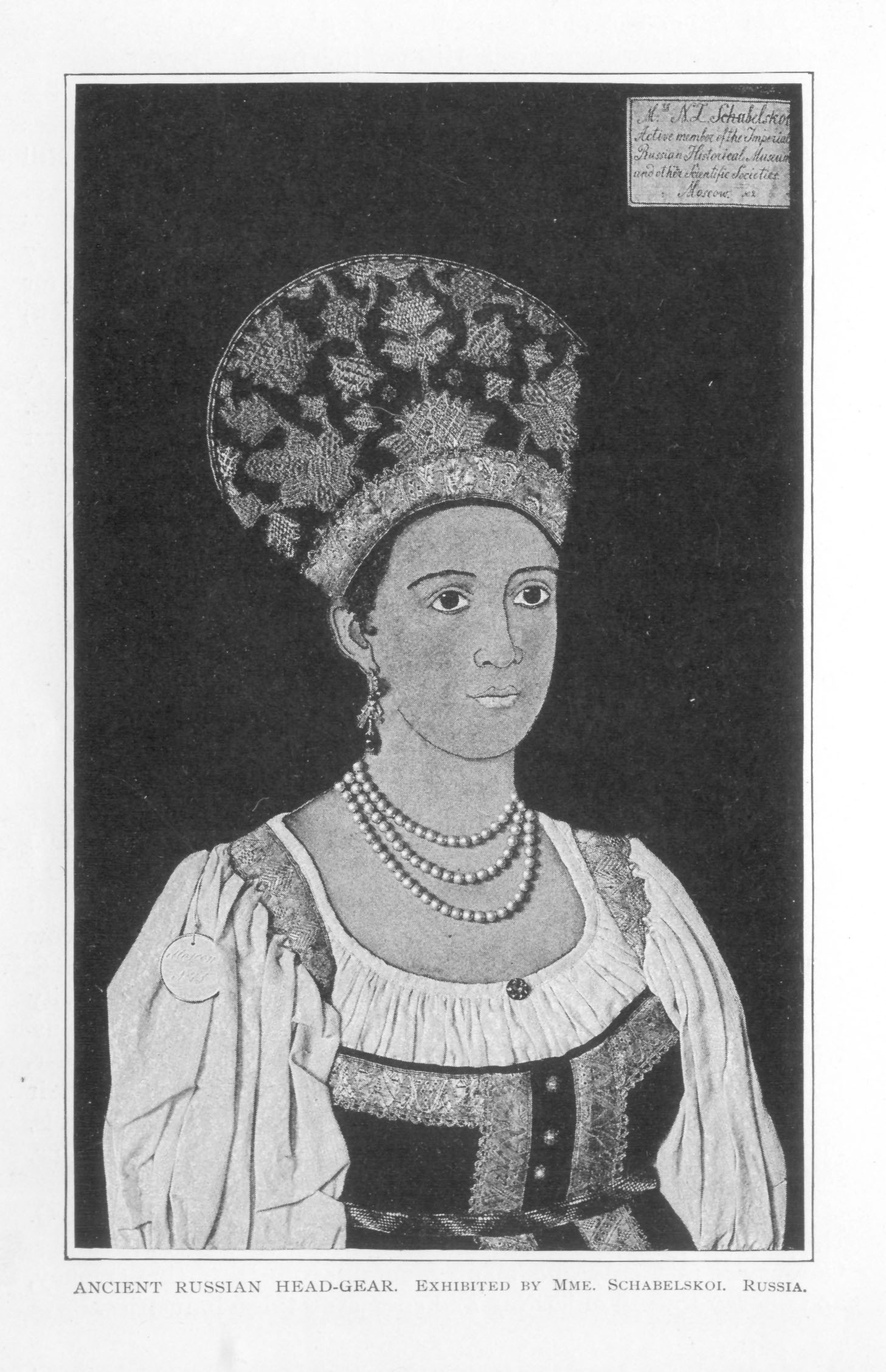
ANCIENT RUSSIAN HEAD-GEAR.
EXHIBITED BY MME. SCHABELSKOI.
RUSSIA.
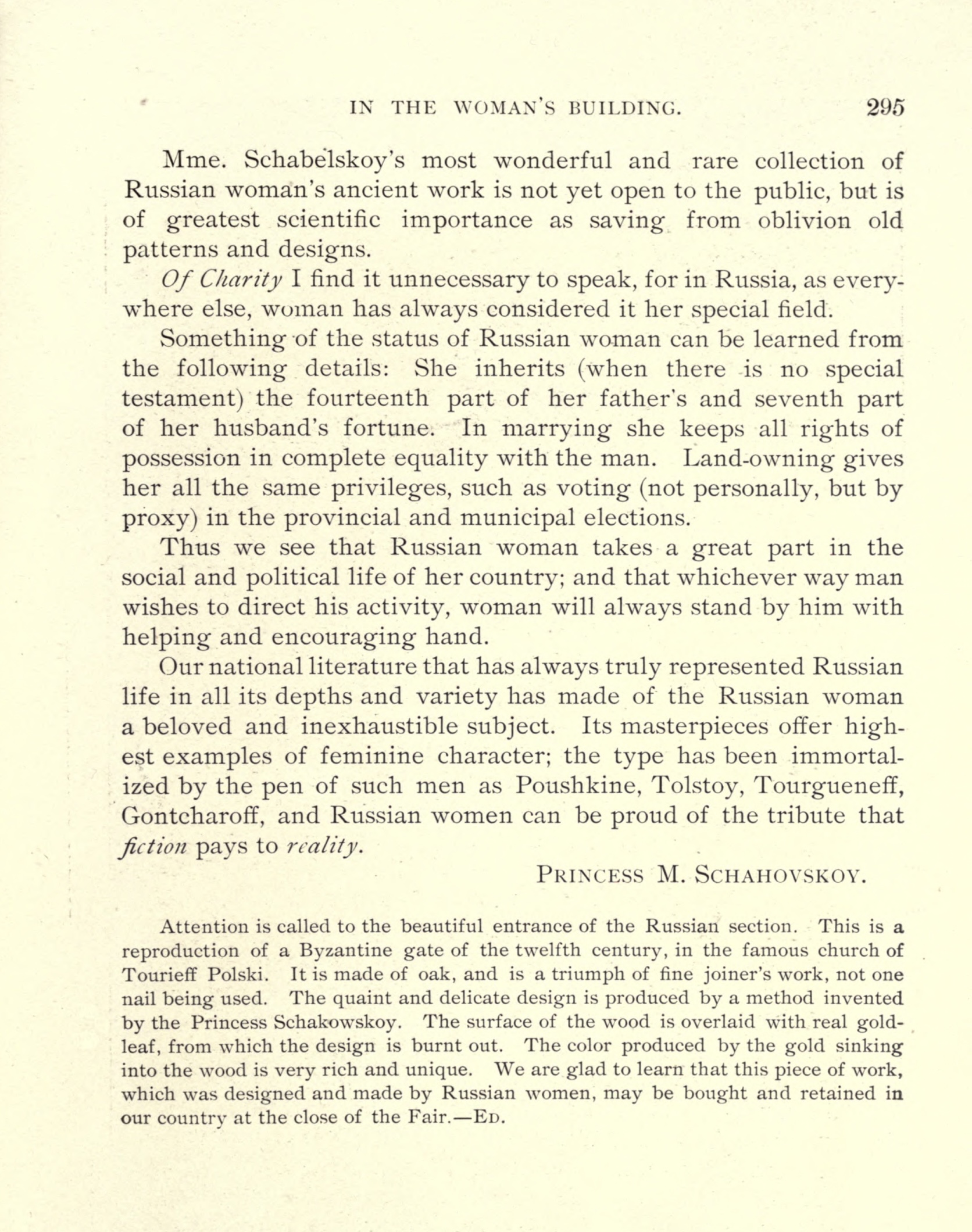
Mme. Schabelskoy's most wonderful and rare collection of Russian woman's ancient work is not yet open to the public, but is of greatest scientific importance as saving from oblivion old patterns and designs.
Of Charity I find it unnecessary to speak, for in Russia, as everywhere else, woman has always considered it her special field.
Something of the status of Russian woman can be learned from the following details: She inherits (when there is no special testament) the fourteenth part of her father's and seventh part of her husband's fortune. In marrying she keeps all rights of possession in complete equality with the man. Land-owning gives her all the same privileges, such as voting (not personally, but by proxy) in the provincial and municipal elections.
Thus we see that Russian woman takes a great part in the social and political life of her country; and that whichever way man wishes to direct his activity, woman will always stand by him with helping and encouraging hand.
Our national literature that has always truly represented Russian life in all its depths and variety has made of the Russian woman a beloved and inexhaustible subject. Its masterpieces offer highest examples of feminine character; the type has been immortalized by the pen of such men as Poushkine, Tolstoy, Tourgueneff, Gontcharoff, and Russian women can be proud of the tribute that fiction pays to reality.
PRINCESS M. SCHAHOVSKOY.
Attention is called to the beautiful entrance of the Russian section. This is a reproduction of a Byzantine gate of the twelfth century, in the famous church of Tourieff Polski. It is made of oak, and is a triumph of fine joiner's work, not one nail being used. The quaint and delicate design is produced by a method invented by the Princess Schakowskoy. The surface of the wood is overlaid with real gold-leaf, from which the design is burnt out. The color produced by the gold sinking into the wood is very rich and unique. We are glad to learn that this piece of work, which was designed and made by Russian women, may be bought and retained in our country at the close of the Fair.—ED.

Engraved by Rand, McNally & Co.
BUREAU OF PUBLIC COMFORT.
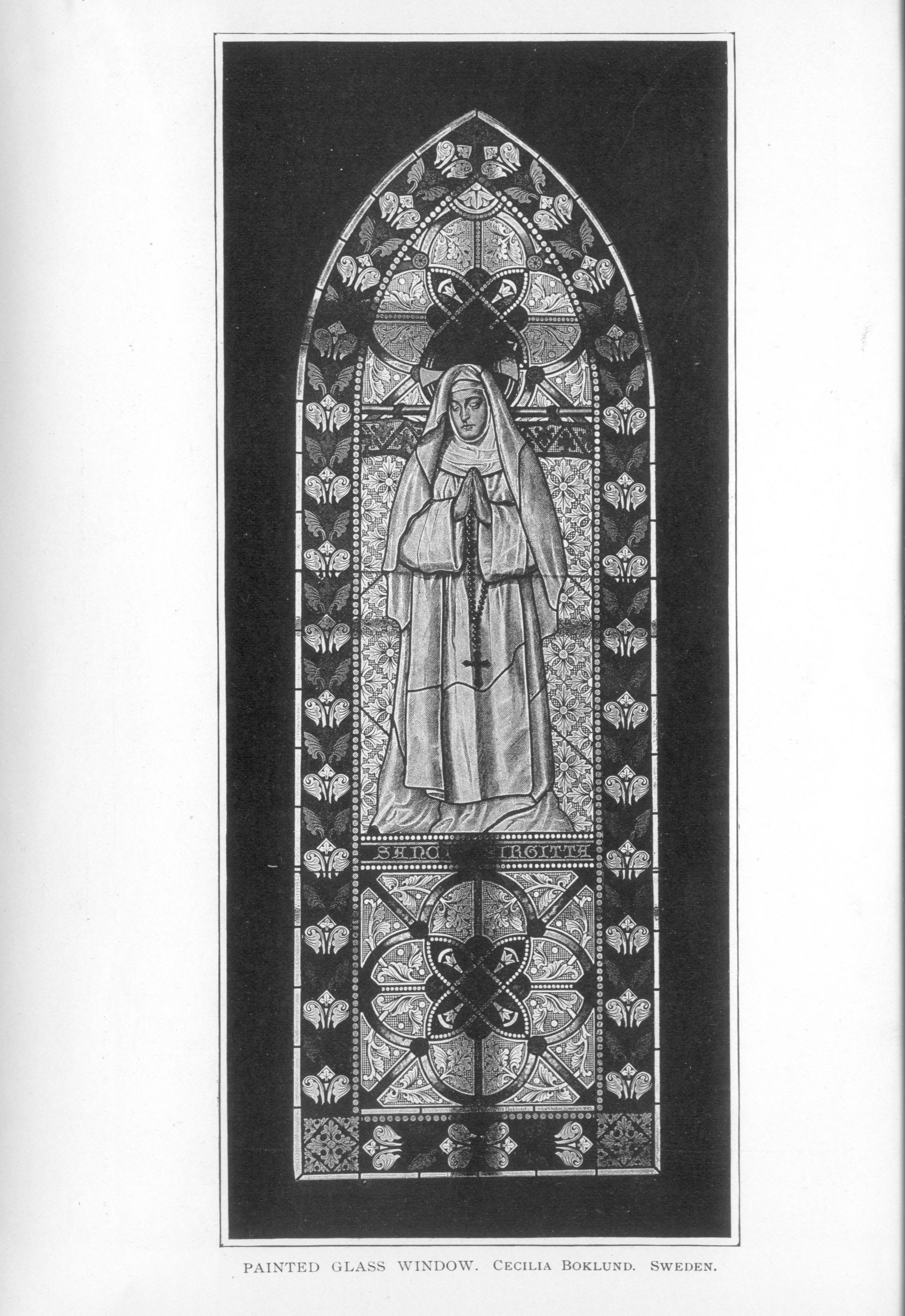
PAINTED GLASS WINDOW.
CECILIA BOKLUND.
SWEDEN.
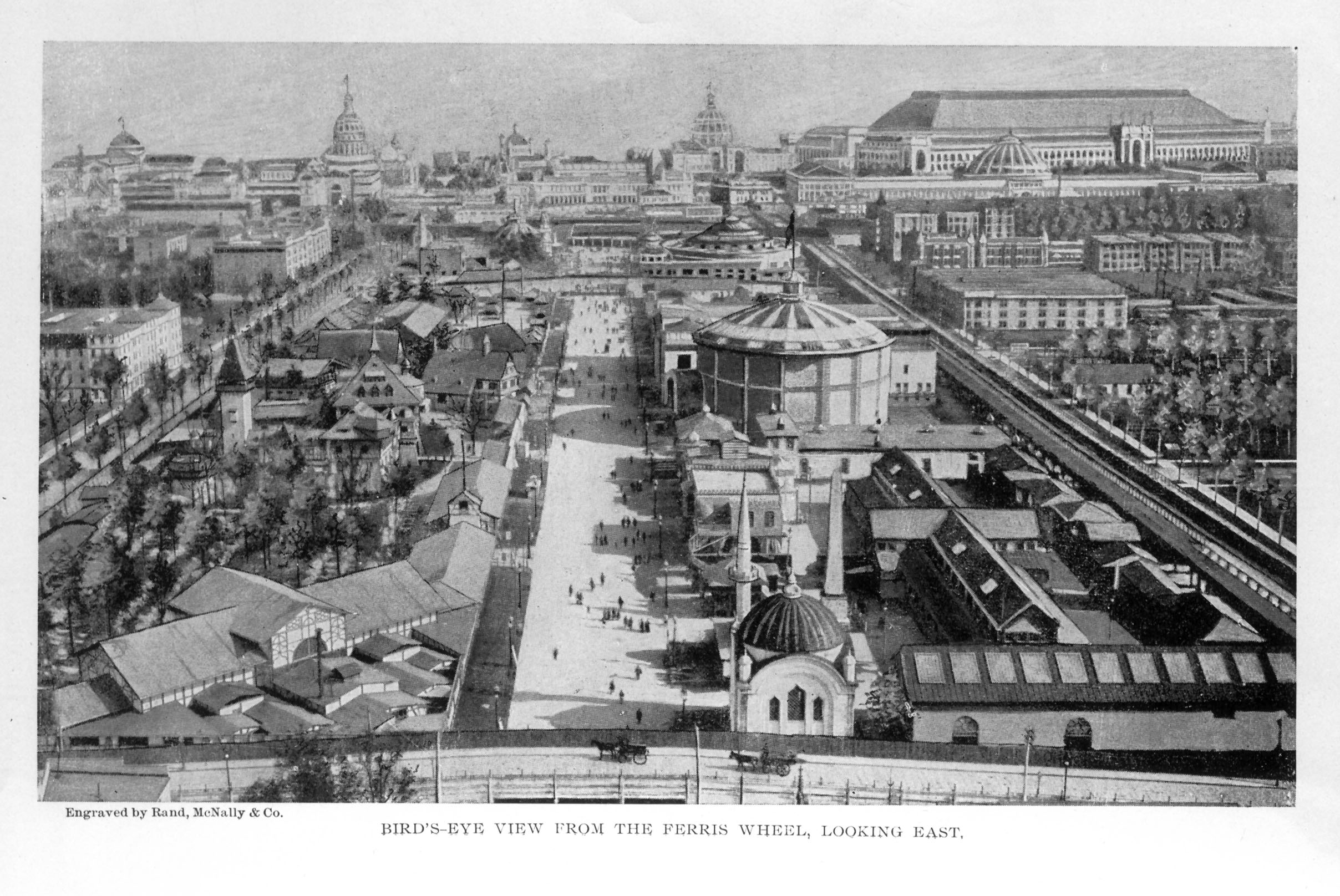
Engraved by Rand, McNally & Co.
BIRD'S-EYE VIEW FROM THE FERRIS WHEEL, LOOKING EAST.